Plasticity, fatigue, and fracture of materials are usually initiated by local deformation processes. Detecting and understanding the underlying mechanisms is the key to improve the mechanical performance and lifetime of miniaturized materials and also of macroscopic materials. Many advanced structural materials possess complex multiphase microstructures where the mechanical interplay of the different phases and their interfaces is poorly understood. Similarly, functional materials employed in modern micro and nano-technologies are composed of material stacks and/or of different phases and possess confined geometries such as thin films, lines, rods, etc… Such micro- or nanosized materials often show a completely different mechanical performance compared to their bulk counterparts as a consequence of confinement effects. The mission of the Department Structure and Nano-/Micromechanics is



